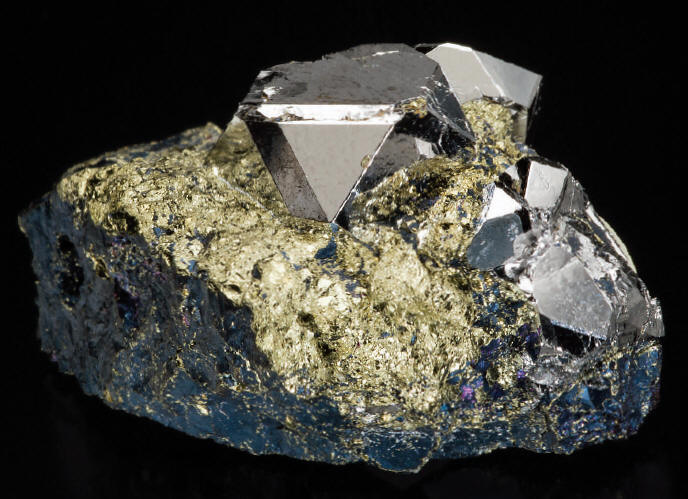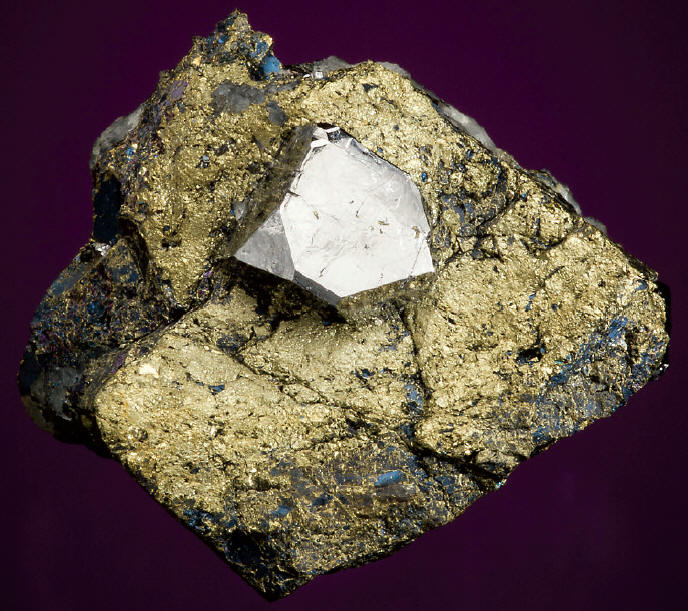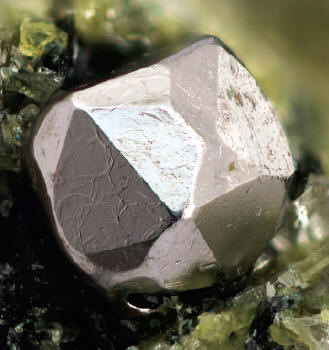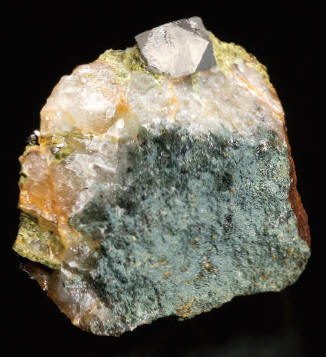Author: Bradley S. WILSON Date: 2014-9-23 19:28:32
In total, over 400 specimens werecollected, with sperrylite crystals rangingin size from under 1 to 15 mm andranging in quality from poor to excellent.
SPERRYLITE
Sperrylite from the Broken Hammerzone occurs as isolated, mostly complete,well-formed, euhedral crystals with bright silver-white, highly reflectivecrystal faces. All were found encased inmatrix and later exposed mechanically.

Sperrylite crystal in chalcopyrite, crystal 1.3 cm wide. Wallbridge specimen. M. Bainbridge photo.

Sperrylite crystal in chalcopyrite, crystal 1.1 cm wide. Wallbridge specimen. M. Bainbridge photo.
At least five types of matrix were identified:massive chalcopyrite, massive milleriteintermixed with lesser amounts ofchalcopyrite, an epidote-quartz-rich matrixwith variable grain sizes and mineralratios, a porous rusty gossanousmatrix (likely a product of surfaceweathering of the sulphides) and rustybreccia consisting of rock fragmentsheld together with iron oxides (likely aweathering product as well). The majorityof specimens with crystals greaterthan 5 mm came from one small zonewhere the matrix was chalcopyrite, rustygossan or rusty breccia. As might be expected,very few undamaged crystalswere found in either the rusty gossan orrusty breccia. The majority of specimenswith small sperrylite crystals (less than5 mm) have an epidote-quartz matrix, althoughcrystals as large as 9 x 8 x 8 mmare known in this matrix type. This is unlikemost sperrylite specimens from elsewherein the world, where matrixconsists primarily of sulphides.
Probably the finest specimen fromthe Broken Hammer zone consists of asharp, isolated sperrylite crystal, 13 x 11mm across, that sticks out 8 mm froma massive chalcopyrite matrix 5 cmacross. It’s a stunning masterpiece of nature.
Crystal forms on Broken Hammersperrylite appear to be similar to those described for sperrylite from other localities.
The most common forms are thecube and octahedron. Some crystalsseem to possess a simple cubo-octahedralhabit, while others are far morecomplex. In addition to the cube andoctahedron, many crystals appear todisplay pentagonal-dodecahedral andtrapezohedral-trisoctahedral forms thattruncate the edges of cube faces or cubeoctahedronfaces, respectively. Mostsperrylite crystals are not ideally developedand therefore some of the forms areeither exaggerated or absent.

Sperrylite crystal, 1.3 cm across, in chalcopyrite matrix, specimen 5 cm wide. Wallbridge specimen. M. Bainbridge photo.
PERSPECTIVES
Wallbridge Mining is in process ofdetermining the economics of the BrokenHammer deposit, and thus of decidingwhether or not they will commence withdeveloping a Cu-Ni-PGM mine. If a metalmine is not opened the prospects for anotherbonanza of fine sperrylite specimensseem low because most of thecurrently known surface exposures havebeen heavily collected. If a mine is developedon this site, then the future looksbright for the potential recovery of additionalfine sperrylite specimens.
ACKNOWLEDGEMENTS
The author would like to thanksome of the many people at WallbridgeMining Company Limited for their helpwith this article, specifically, Tom Johnsonfor help in the field with logistics andspecimen collection, Attila Péntek forproviding useful comments and suggestionsand Alar Soever, company CEO, forrecognizing the specimen potential ofthis discovery and having the vision tohelp preserve our mineral heritage. Theauthor would also like to thank AleksanderRecnik for help with crystallographyand crystal drawings, JohnRakovan for suggestions and comments,Tom Moore for editing and Paul Craganfor making comments.

Sperrylite crystal in epidote matrix, crystal 1.2 mm wide. D. Joyce specimen. J. Jaszczak photo.

Sperrylite crystal in epidote matrix, crystal 4.5 mm high. Wallbridge specimen. M. Bainbridge photo.

Sperrylite crystal in quartz-epidote matrix, specimen 4 cm wide. Wallbridge specimen. M. Bainbridge photo.








 YueGongAnBei 44051102000467
YueGongAnBei 44051102000467


 |
|